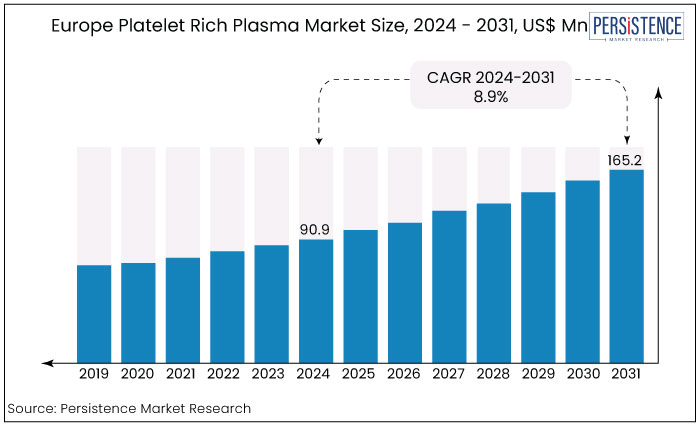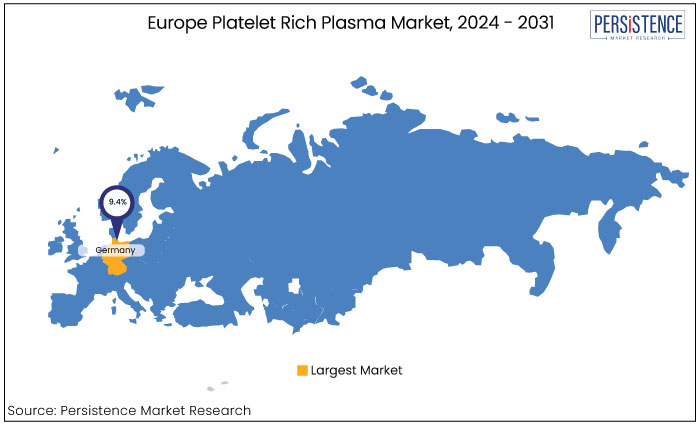Europe Platelet Rich Plasma Market
Industry: Healthcare
Published Date: November-2024
Format: PPT*, PDF, EXCEL
Delivery Timelines: Contact Sales
Number of Pages: 188
Report ID: PMRREP34895
The Europe platelet rich plasma market is projected to witness a CAGR of 8.9% during the forecast period from 2024 to 2031. It is anticipated to increase from US$ 90.9 Mn recorded in 2024 to a staggering US$ 165.2 Mn by 2031. Increasing prevalence of sports injuries, rising demand for aesthetic treatments, and high popularity of regenerative medicine are expected to create new opportunities in the market.
According to the European Injury Data Base, every year, nearly 4.5 million individuals belonging to the age group of 15 years and above are treated for sports injuries across the European Union (EU). Football mainly accounts for around 40% of all hospital-treated sports injuries in the region. The numbers are projected to rise in the forecast period with increasing sports events across the U.K. and Germany, thereby pushing platelet rich plasma demand.
Platelet rich plasma is set to be considered an ideal alternative to surgical procedures and synthetic treatments. Increased awareness of its benefits, along with growing healthcare expenditure, especially in Western Europe, further supports market expansion.

Key Highlights of the Market
|
Market Attributes |
Key Insights |
|
Market Size (2024E) |
US$ 90.9 Mn |
|
Projected Market Value (2031F) |
US$ 165.2 Mn |
|
Europe Market Growth Rate (CAGR 2024 to 2031) |
8.9% |
|
Historical Market Growth Rate (CAGR 2019 to 2023) |
7.5% |
|
Country |
CAGR through 2031 |
|
Germany |
9.4% |
Germany is anticipated to dominate Europe’s platelet rich plasma injection industry in the evaluation period at a CAGR of 9.4%. This is attributed to the presence of an innovative healthcare infrastructure, investments in research and development, and high adoption rates of unique medical treatments.
Germany-based clinics and hospitals increasingly use PRP in areas such as orthopedics, sports medicine, and aesthetics, driven by rising demand for minimally invasive procedures. Additionally, the country has a robust regulatory environment that supports the safe and effective use of PRP therapies, which boosts patient trust and market growth.
The country’s surging aging population further contributes to the growing demand for regenerative medicine, further cementing its leadership in Europe. As per the Federal Statistical Office of Germany, until the mid-2030s, Germany's population of adults 67 and older will increase by approximately 4 million, reaching at least 20 million. These numbers are predicted to skyrocket in the forecast period, thereby bolstering demand in the country.

|
Category |
CAGR through 2031 |
|
Product Type - Pure Platelet Rich Plasma (P-PRP) |
9.1% |
Pure platelet rich plasma (P-PRP) is leading in terms of product type due to its broad applicability and high safety profile. P-PRP, containing a high concentration of platelets without leukocytes minimizes inflammation and risk of immune response. This makes it ideal for regenerative treatments in orthopedics, sports medicine, and aesthetics.
Its efficacy in accelerating tissue healing and repair has gained the trust of healthcare providers and patients seeking minimally invasive options. Additionally, P-PRP’s versatility allows it to be easily integrated into various therapeutic procedures, supporting its dominance in Europe’s platelet rich plasma shots? industry.
|
Category |
CAGR through 2031 |
|
Origin - Autologous Platelet Rich Plasma |
9.3% |
By origin, the autologous segment is anticipated to lead with a high platelet rich plasma market share in Europe. Growth is primarily attributed to its high safety and compatibility.
Derived from the patient’s own blood, autologous PRP significantly reduces the risk of immune reactions, infections, and transmission of diseases. These features make it the preferred choice in clinical applications across Europe.
Superior compatibility of autologous PRP ensures better patient outcomes, especially in treatments like orthopedics, sports injuries, and cosmetic procedures, where rapid healing and minimal side effects are essential. Furthermore, Europe’s regulatory standards favor autologous treatments for their high safety. This encourages widespread adoption among local healthcare providers, driving market growth in the region.
The Europe platelet rich plasma market growth is rising rapidly, driven by increasing demand for regenerative therapies across various medical fields such as orthopedics, sports medicine, cosmetics, and dentistry. PRP, which uses a concentration of platelets from a patient's own blood, has gained popularity due to its ability to promote natural healing with minimal side effects.
The market growth is set to be fueled by the increasing prevalence of musculoskeletal injuries, demand for aesthetic treatments, and rising cases of age-related degenerative conditions, which are common among Europe’s aging population. Trends in the region’s platelet rich plasma therapy? industry indicate a growing preference for autologous PRP as it reduces infection risks and immune responses, aligning with stringent healthcare regulations.
Pure platelet rich plasma (P-PRP) is also leading among product types due to its low leukocyte content, reducing inflammation and providing effective outcomes. Technological advancements in PRP preparation systems are simplifying procedures, making treatments highly accessible. As awareness and acceptance of PRP therapy continue to rise, Europe is anticipated to extend significantly, with an emphasis on minimally invasive and patient-specific treatment options.
The Europe platelet rich plasma market recorded a decent CAGR of 7.5% during the historical period from 2019 to 2023. This was mainly due to increased awareness of PRP's benefits in accelerating tissue repair and recovery across various medical specialties.
Initially used only in orthopedics and sports medicine, PRP therapy has recently expanded into aesthetics and cosmetic applications, dentistry, and wound healing. It has become a crucial solution for minimally invasive treatments, which are mainly demanded by the geriatric population. The market will likely witness a CAGR of 8.9% through 2031 amid ongoing innovations in simplified PRP preparation and application.
Growing Use of PRP in Dentistry, Dermatology, and Aesthetics to Boost Demand
The Europe platelet rich plasma market is set to witness a surging use across diverse therapeutic and clinical fields. It is mainly driven by the growing appeal of regenerative treatments that leverage the body’s own healing mechanisms.
PRP’s applications have expanded beyond orthopedics and sports medicine to encompass aesthetics, dermatology, dentistry, wound care, and even hair restoration. This growing use is fueled by increasing demand for minimally invasive, natural therapies with fewer side effects from patients.
PRP aids in joint, ligament, and tendon repair in orthopedics, while in aesthetics, it is used for anti-aging treatments and scar reduction. Increasing prevalence of chronic conditions and surging aging population in Europe further support PRP adoption, as patients seek effective solutions to manage pain, heal injuries, and enhance quality of life.
Continuous advancements in PRP preparation technologies and strong support from healthcare providers are additional drivers, positioning the Europe PRP market for significant growth across multiple medical fields.
High Demand for Minimally Invasive Cosmetic Treatments to Bolster Sales
Europe market is experiencing significant growth due to the rising demand for cosmetic and aesthetic treatments. Consumers are increasingly seeking natural, minimally invasive options to improve skin texture, reduce wrinkles, and promote hair growth. This is further leading to a rising adoption of PRP in beauty and anti-aging therapies.
PRP’s ability to stimulate collagen production and accelerate tissue repair makes it highly effective for skin rejuvenation and scar reduction. It aligns with the preferences of Europe’s health-conscious and aging population.
PRP treatments appeal to individuals looking for low-risk solutions, as they use the patient's own blood, reducing the risk of adverse reactions. This demand, combined with innovations in PRP application methods, is a strong driver for growth, solidifying Europe’s position as a key market for cosmetic PRP treatments.
Stringent Regulatory Framework May Hamper Platelet Rich Plasma Therapy Demand
Regulatory delays stemming from the need for FDA approval are set to significantly hamper growth in the market. The stringent regulatory framework established by the FDA necessitates thorough evaluations and extensive clinical trials before products can gain market access.
Protracted approval process can deter innovation and slow down the introduction of new PRP therapies, limiting options for healthcare providers and patients. Hence, companies may hesitate to invest in research and development activities or face challenges in meeting regulatory requirements, ultimately affecting the competitiveness of Europe’s market.
Rise of Social Media Creates Opportunities for Cosmetic PRP Treatment Providers
The trend for significant skin enhancement through cosmetic PRP treatments represents a valuable opportunity in the Europe platelet rich plasma market. As consumers increasingly seek non-surgical solutions for improving skin texture, tone, and appearance, PRP therapy has emerged as an appealing option due to its natural and regenerative properties.
The ability of PRP to stimulate collagen production and promote skin rejuvenation aligns with the growing trend toward minimally invasive cosmetic procedures.
The rise of social media and influencer culture has surged awareness and demand for effective skincare treatments, further driving interest in PRP. This trend offers manufacturers and practitioners an opportunity to broaden their offerings, educate potential clients, and capitalize on the burgeoning aesthetic market in Europe.
The competitive landscape of Europe market is characterized by a mix of established companies and emerging players, each striving to innovate and capture high shares. Key industry participants include biotechnology firms, medical device manufacturers, and specialized clinics offering PRP treatments across various applications. These application include orthopedics, aesthetics, and wound healing.
Competitive strategies often focus on enhancing product efficacy, optimizing processing techniques, and broadening distribution channels. Additionally, collaborations and partnerships between companies and healthcare providers are becoming increasingly common, aiming to enhance research and development efforts.
The presence of several clinical studies supporting the effectiveness of PRP therapy also fosters competition. It is attributed to the validation of treatment protocols and the emergence of new entrants seeking to explore this evolving market. As a result, the regional market is evolving rapidly, driven by innovation, regulatory advancements, and rising consumer awareness.
Recent Industry Developments
|
Attributes |
Details |
|
Forecast Period |
2024 to 2031 |
|
Historical Data Available for |
2019 to 2023 |
|
Market Analysis |
US$ Million for Value |
|
Key Countries Covered |
|
|
Key Market Segments Covered |
|
|
Key Companies Profiled in the Report |
|
|
Report Coverage |
|
|
Customization and Pricing |
Available upon request |
By Product Type
By Origin
By Application
By Country
To know more about delivery timeline for this report Contact Sales

The market is set to reach US$ 165.2 Mn by 2031.
Germany is estimated to lead with a high market share in 2031.
Arthrex, Inc. and Stryker Corporation are the leading providers in Europe.
As of 2024, Arthrex, Inc. has been dominant.
It will likely rise at a CAGR of 8.9% from 2024 to 2031.